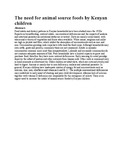The need for animal source foods by Kenyan children

View/
Date
2003Author
Bwibo, NO
Neumann, CG
Type
ArticleLanguage
enMetadata
Show full item recordAbstract
Food intake and dietary patterns in Kenyan households have been studied since the 1920s. Reports on breastfeeding, nutrient intake, micronutrient deficiencies and the impacts of malaria and intestinal parasites on nutritional status are reviewed. Diets are mainly cereal-based, with tubers and a variety of vegetables and fruits when available. White maize, sorghum and millet are high in phytate and fiber, which inhibit the absorption of micronutrients such as zinc and iron. Communities growing cash crops have little land for food crops. Although households may own cattle, goats and poultry, commonly these are not consumed. Adults in nomadic communities consume more meat than nonpastoralists. Lakeside and oceanside communities do not consume adequate amounts of fish. Poor households have a limited capacity to grow and purchase food, therefore they have more nutrient deficiencies. Early weaning to cereal porridge deprives the infant of protein and other nutrients from human milk. Other milk is consumed only in small amounts in sweetened tea. Older children eat adult diets, which are extremely bulky and hard to digest. Anemia is mainly due to iron deficiency, malaria and intestinal parasites. In general, Kenyan children have inadequate intakes of energy, fat and micronutrients such as calcium, zinc, iron, riboflavin and vitamins A and B-12. The multiple micronutrient deficiencies may contribute to early onset of stunting and poor child development, whereas lack of calcium together with vitamin D deficiency are responsible for the resurgence of rickets. There is an urgent need to increase the intake of animal source foods by Kenyan children
URI
http://www.ncbi.nlm.nih.gov/pubmed/14672293http://erepository.uonbi.ac.ke:8080/xmlui/handle/123456789/16000
Citation
J Nutr. 2003 Nov;133(11 Suppl 2):3936S-3940SPublisher
Department of Pediatrics, Faculty of Medicine, University of Nairobi Department of Community Health Sciences and Pediatrics, Schools of Public Health and Medicine, University of California Los Angeles, Los Angeles, CA
Collections
- Faculty of Health Sciences (FHS) [10387]
